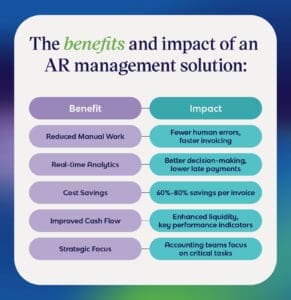5 tips to mastering the accounts receivable process
Corcentric

Mastering the accounts receivable process is more than a financial task — it’s a strategic approach to optimizing cash flow, improving customer relations, and safeguarding your company’s financial health. Without a solid handle on accounts receivable management, cash flow can quickly become…unpredictable, putting your business in a precarious position.
But with the right strategies, you can reduce DSO (days sales outstanding), accelerate payment cycles, and keep your balance sheet healthy. The key? Applying best practices that streamline everything from invoicing to customer communication, whether you do this in-house, or use managed services from an expert like Corcentric. Let’s explore five essential tips that will help you elevate your accounts receivable game.
Tip 1: Set clear, enforceable credit policies
The foundation of any effective accounts receivable process starts with setting — and sticking to — clear credit policies. When customers know the terms upfront, there’s far less room for misunderstandings or delayed payments. A well-defined credit policy should include clear payment terms, like how long customers have to pay (30, 60, 90 days, etc.), late fees, and credit limits. Think of it as a roadmap: when the rules are transparent, customers are less likely to veer off course, and your team will have the framework needed to hold everyone accountable.
But just setting the rules isn’t enough. Make sure that your internal team is aligned on these policies. Everyone from your sales team to customer service should understand and communicate these terms clearly to customers. And here’s a critical point—don’t let your credit policies grow stale. Periodic reviews are essential, especially as your customer base or market conditions shift. If a customer’s payment behavior changes, adjust credit limits accordingly. This ensures that you aren’t overextending credit to high-risk customers and helps prevent late payments before they become a problem.
Moreover, these policies should extend to your collections process. A structured, consistent approach to following up on outstanding invoices is key to reducing DSO and maintaining positive cash flow. By having a proactive collections strategy in place, you can address late payments quickly and professionally, which, in turn, strengthens customer relationships.
Tip 2: Invoice swiftly and with precision
Timely and accurate invoicing is the quintessence of your accounts receivable process: The moment a product is shipped or a service is rendered, the invoice should follow, ideally within 24 hours. Prompt invoicing ensures that the payment process starts immediately, reducing DSO and giving customers a clear expectation of when payment is due.
But remember — speed without accuracy can backfire. An invoice riddled with errors will only delay payment, as customers dispute the charges and your team scrambles to resolve the issue.
That’s where automation comes in. In today’s digital world, manual invoicing processes are outdated and prone to human error. Investing in automated invoicing software can significantly streamline this process, making sure invoices go out quickly and accurately (e-invoicing is also mandatory in parts of the world, a trend which is growing). The result? Shorter billing cycles, reduced errors, and a higher likelihood of receiving payment within the agreed-upon terms. For businesses processing large volumes of invoices, automation is non-negotiable. Automated systems can handle thousands of electronic invoices annually, whereas traditional paper invoicing limits companies to far fewer transactions and slows down the entire process.
Automation also allows for real-time tracking of invoice status. Instead of manually tracking which customers have paid and which invoices are overdue, your AR software can do the heavy lifting. With the right system, you can generate reports at the touch of a button, showing you exactly where your cash flow stands at any given moment.
Tip 3: Provide flexible payment options to boost convenience
Forget cash: in today’s fast-paced business environment, convenience is king. Offering your customers multiple payment options can make all the difference in reducing DSO by taking the friction out of prompt payments. Gone are the days when accepting checks and bank transfers were enough. Now, customers expect to pay in the way that suits them best — whether that’s via credit card, debit card, ACH transfers, or even virtual cards. The more options you provide, the fewer excuses customers have for delaying payment.
By integrating a payment portal that’s accessible 24/7, you’re not just providing convenience — you’re speeding up your payment cycle. This online accessibility means customers can make payments on their time, regardless of business hours, reducing friction in the process. Payment systems that automatically integrate with your accounts receivable management software also keep track of all incoming payments in real time, making it easier to reconcile accounts and monitor cash flow.
Offering a variety of payment methods can also improve customer satisfaction. By allowing them to choose their preferred method of payment, you’re enhancing their experience while simultaneously benefiting your cash flow. Ultimately, more payment options equal faster payments and fewer overdue invoices.
Tip 4: Leverage an AR management solution
Technology is your best ally when it comes to managing accounts receivable efficiently. Manual in-house processes are a recipe for errors, delays, and inefficiencies. That’s why leveraging an AR management solution is one of the most effective ways to streamline your entire invoicing and collections process. This takes care of repetitive tasks, reduces human errors, and provides real-time visibility into your cash flow.
AR management solutions offer a host of features that improve efficiency, from automatic payment reminders to real-time analytics that provide actionable insights into your accounts receivable performance. By using these tools or services, you can identify patterns, predict which customers are likely to pay late, and take preemptive action. Whether it’s sending a reminder before a payment is due or offering early payment discounts, the data provided by AR software helps you make informed decisions that enhance your cash flow.
One of the biggest advantages of AR management solutions are their ability to lower the costs associated with processing invoices. Studies have shown that businesses can save up to 80% per invoice by automating the process. For a company processing thousands of invoices annually, that translates to significant cost savings, freeing up capital that can be reinvested in growth initiatives.
The benefits and impact of an AR management solution:

The holistic view offered by comprehensive AR solutions illuminates critical data, such as payment due dates and amounts owed, which aids in effective cash management and bolsters the overall financial health of the business.
Tip 5: Stay proactive in customer communications
Finally, proactive communication is critical for keeping accounts receivable running smoothly. Customers are more likely to pay on time when they feel engaged and informed. Establishing clear communication from the start — including outlining payment terms and deadlines — sets the tone for the entire relationship. It’s important to keep that communication going throughout the billing cycle.
Regular follow-ups on outstanding invoices not only serve as a reminder for customers to pay but also show that you’re on top of your processes. The key is to strike the right balance between friendly reminders and firm professionalism. An AR management solution can send payment reminders at scheduled intervals, ensuring consistency without burdening your team with manual follow-ups.
On the flip side, open lines of communication also make it easier for customers to reach out with questions or concerns. Offering dedicated customer support for payment-related inquiries can alleviate any confusion that might delay payment. The more responsive and transparent you are, the more trust you build — and trust leads to prompt payments, and hopefully more business.
Conclusion: optimizing your accounts receivable process is a long-term investment
Optimizing accounts receivable management is about more than collecting payments on time — it’s about building a framework that supports sustainable growth. By implementing these five tips — setting clear credit policies, invoicing quickly and accurately, offering flexible payment options, leveraging technology, and maintaining open communication — you’re not only reducing DSO but creating a system that enhances your cash flow and strengthens customer relationships.
Ultimately, a well-managed accounts receivable process is a long-term investment in your business’s financial health. It provides the predictability and control you need to navigate cash flow challenges while freeing up resources for growth. And when done right, it doesn’t just benefit your balance sheet—it becomes a strategic advantage that supports every aspect of your business. To learn more, check out The Ultimate Guide to Accounts Receivable Management.
